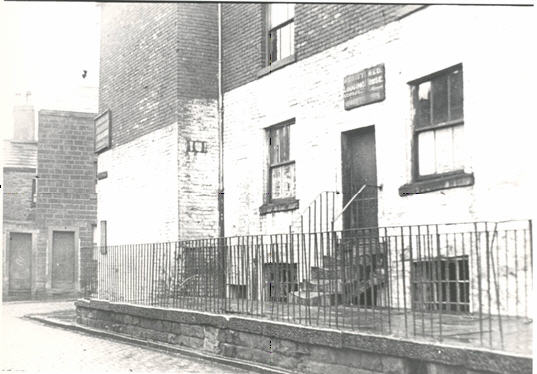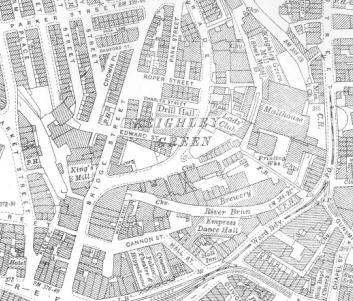Burnley Family History
We know from Census records that our family were Irish immigrants that settled in the 'Park District' of Burnley during the 1850's. The 'park' districted developed around the mills on the river and houses were built for the workers. In the early 1800's Edward strreet, Roper Streer and Charles street were already established and were soon to become the birth places of our family.
Early Beginning of 'The Park District'
To better understand the circumstances in the 'IRISH Park' here is an extract from a Burnley District Historical Society Publication . See copy in Burnley Library.
Burnley District Historical Society Publication RETROSPECT Vol 8 1988 written by Gerad Durkin
I am indebted to Peter Smith and to Eric Higham for background information on mid—nineteenth century Burnley. (1,2.)
The district generally known as the Park was bounded by Curzon Street, Bankhouse Street, Bank Parade and the River Brun running (partly covered in) from the bottom of Bank Parade to the junction of Market Street and Curzon Street. The district attracted to itself the occasional name of the ‘Irish Park’, though the proportion of Irish immigrants living there in the mid— nineteenth century was not so high as in Wapping and the streets round St. James’s Church!
At that time, in the part of the Park round Charles Street and Edward Street, Irish immigrants formed 1 in 13 of the population and, round Mosley Street and South Street, 1 in 25!
According to Solow, as quoted by P. Smith(2), these migrants in general, driven out of Ireland by chronic hunger and periodic famine, constituted in their flight to the industrial areas of northern England the most dramatic population loss known to Western society. A strong and persistent oral tradition has it that the immigrants into Burnley came from North Connaught. Since they were destitute, they took the cheapest accommodation they could find in the already rotting inner core of Burnley. No doubt, too, the flow of Irish people into these districts was helped by the opening of Bank Top Station in l849. Here they lived close together in clusters formed according to birthplace and accommodation. (l,2)
If the migrants into Burnley were like the generality of Irish famine refugees — there is no reason to suppose they were different — then they left their homes in Ireland in emigration groups under the guidance of an elected leader and with the formal blessing of their parish priest (3), for they were Roman Catholics virtually to a man. Of this immigrant population, approximately 1 in 4 were employed in textiles as this industry offered easily acquired skills to an unskilled people. Others were employed in the l840’s in work on the railway to Burnley, which was then under construction, hut most survived on the fringes of the local economy as hawkers, rag pickers and beggars. (1,2,4)
P. Higham points to the relative lack of evidence of permanent settlement.(2) This view is supported by oral tradition. Within a generation, the children of famine Settlers moved into more salubrious areas of Burnley, built, for example, under the Improvement Act of 1856. Others left Burnley for such places as Liverpool, U.S.A. notably Massachusetts) and South America.(5).
But, for many generations and well into the twentieth century, the Park continued to house the descendants of famine immigrants, many continuing to carry the ailments and scars of ancient poverty. As has been said, the immigrants were mainly Catholics but from an early date, some drifted away from their Catholic allegiance. (5,6) Others clung to their traditional faith but, after the experience of famine, closed their minds to all things Irish.(5) Among others again, these developed a transplanted Irish nationalism, manifesting itself in a romantic view of Ireland, far from reality. So parlour walls were hung with framed texts, bearing the legend “God save Ireland”, portraits of Gladstone and religious statues kept under domed glass on dressers. But this was long after Cardinal Cullen and secular leaders had restored the morale of Irish people so badly damaged by famine. For the famine generation, it is no exaggeration to say that they were ashamed of their Gaelic mother tongue which, in 1841, had been common speech west of a line from Derry to Cork. Faith and fatherland, language and nationality, were slogans for later generations which had recovered from the shock of famine.
But to return, allowing for the leakage mentioned above, the Park, no doubt, contributed to the life of the new catholic parish of St. Mary’s where, in the 1870’s, performances of Sheridan’s “St. Patrick’s day” and BoucicauIt’s ‘The Colleen Bawn”(7) doubtless helped to keep strong the Irish identity. A lady brought up n the Park died a few years ago, in extreme old age. She says that in Edward Street, in the 1880’s, on sunny Sunday afternoons young women would come to their doors and take part in community singing. No transistors then.
By the 1880’s, Irish Catholics and English Catholics were beginning to inter-marry, (3) a sure sign of the start of the assimilation of the Irish immigrants.
References
1. E. HIGHAM: An investigation into the migrant population of Burnley 1851.
2. P. SMITH: Migration into Burnley 1851—1881.
3. I can no longer trace the authority for this statement but it is substantially accurate.
4. W. BENNETT: History of Burnley.
5. Oral tradition.
6. K. S. INGLIS: The Churches and the Working Classes in Victorian England.
7. M. DURKIN: A Short history of St. Mary’s, Burney.
Thomas (Hugh) Gallagher - Recollections
Quotes that immigrants were mainly Catholics but from an early date, some drifted away from their Catholic allegiance. Others clung to their traditional faith but, after the experience of famine, closed their minds to all things Irish. Among others again, these developed a transplanted Irish nationalism, manifesting itself in a romantic view of Ireland, far from reality. So parlour walls were hung with framed texts, bearing the legend “God save Ireland”, portraits of Gladstone and religious statues kept under domed glass on dressers. But this was long after Cardinal Cullen and secular leaders had restored the morale of Irish people so badly damaged by famine. For the famine generation, it is no exaggeration to say that they were ashamed of their Gaelic mother tongue which, in 1841, had been common speech west of a line from Derry to Cork. Faith and fatherland, language and nationality, were slogans for later generations which had recovered from the shock of famine.
But to return, allowing for the leakage mentioned above, the Park, no doubt, contributed to the life of the new catholic parish of St. Mary’s where, in the 1870’s, performances of Sheridan’s “St. Patrick’s day” and BoucicauIt’s ‘The Colleen Bawn” doubtless helped to keep strong the Irish identity.

